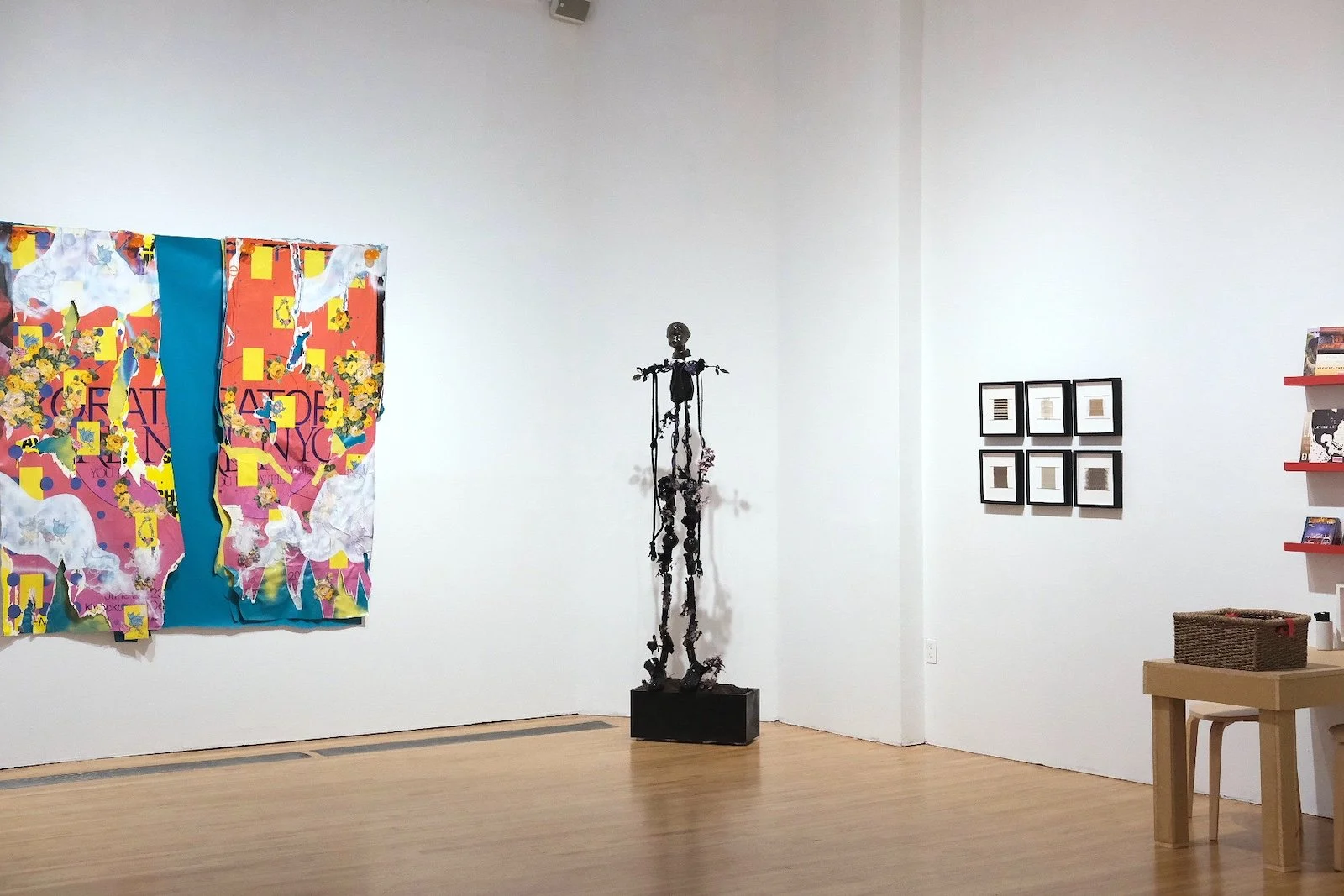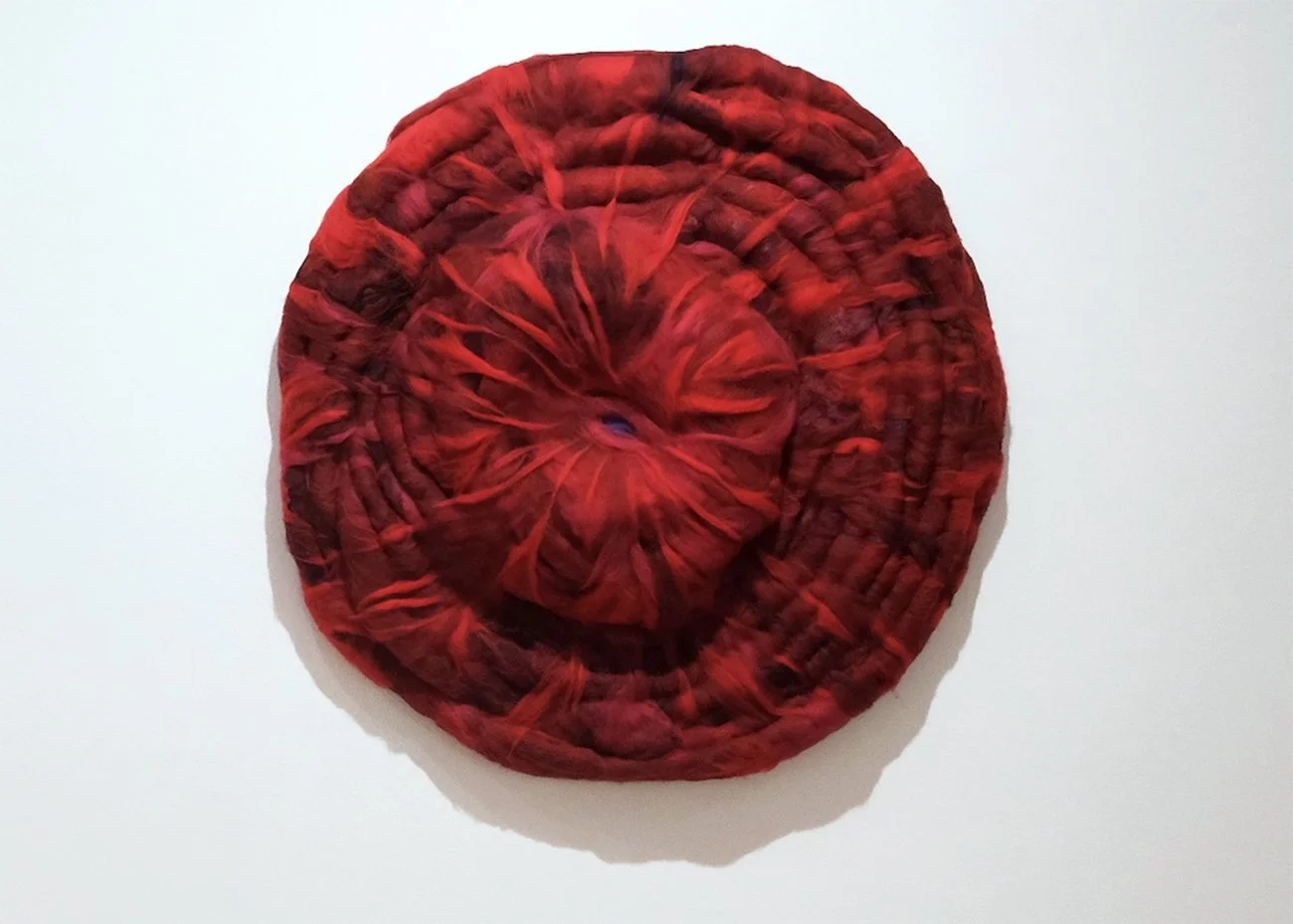Tangled Threads of Work and Play
Artists and those who talk about art often refer to creativity as “work.” The English lexicon is altogether lacking when it comes to poetic words for creative actions—especially ones that can be disentangled from the language of capitalist production. The Spanish verb hacer is more elaborate, signifying “doing” but also “making.” We cannot separate our doing, our actions in life, from what we make, as they are inextricably linked. Nor is the chain of creation traced by our lives a singular one, but more so a net of connected threads among others.
“At the moment when, breaking the rectangle and virtually inverting the surface, which stops being the thickness of the space and becomes the thread of this space, this expression is now inside this real space where all the living and cosmological irradiated forces act.”[1] So utters a small printed zine on the writings of the Brazilian artist Lygia Clark, perched atop the “Collective Weaving + Resource Library” of Obsesión! Labor as Pleasure, a Latinx group show at apexart curated by Francisco Donoso. Here, Clark’s description of the “thickness of the space” is dissipated through pleasure, revealing the living and irradiating threads inherently underlying human activity.
Two pieces by Justin Favela flank the exhibition entrance, Platanos (2024) and Untitled (still life with parrot and fruit), After Frida Kahlo (2024); both utilize thin layered strips of tissue paper often found on piñatas. Colorful and airy, they mark a celebratory occasion. Like Mikhail Bakhtin’s idea of the carnivalesque, la fiesta, the party, and its signifiers, carry the power of inversion, particularly regarding class, gender, race, and other social hierarchies. Essential forms of work often forgotten and even seen as trivial are given room to breathe: play, children’s creativity, the labor of women and queer people, and of those who grow and prepare our food. This is an important theme sustaining Obsesión; a thread running through, tied to a series of inquiries sewn along interstices: How is “art” distinct from la piñata? How do we value and distinguish the labor of those who create our “consumer” objects from what we call art? And is pleasure capable of collapsing these categories into something more fundamental?
Also inverted is the hierarchy of materials. Here, it is accessibility, durability, color, and the ornaments of childhood that take preference. If Favela’s piñata still lives were broken open, we may find the paraphernalia reservoir for the works of Lina Puerta or Maria Yolanda Liebana, as they speak to one another in the language of play. The use of these materials evokes another interstitial question. What of the distinction between craft and art? Whether conscious or not, this distinction carries precarious undertones, as many non-white cultures see little to no difference between the two. Obsesión is situated in the language of craft all the same as art, inasmuch as labor meant to generate pleasure has a definite utility. adrienne maree brown’s notion of “pleasure activism” undergirds the work in exactly this way. “Pleasure activism is the work we do to reclaim our whole, happy, and satisfiable selves from the impacts, delusions, and limitations of oppression and/or supremacy.”[2] Thus, where capitalism and whiteness often see no utility in the arts, a pleasure-driven approach “breaks the rectangle” and “inverts the surface,” revealing that most valuable use: human happiness.
References to food’s incredible capacity to bring joy and gather community manifest throughout the show, with similar questions emerging as to how our pleasure—our personal experience—relates to the labor of others. Food is mentioned not only in the works by Favela, but also in Juan Hinojosa’s HOT LUNCH JAM (2025), Gloria Martinez Granados’s Retrato de Francisco (2025), and Puerta’s Tomatoes and I (Black) from the Kinship Series (2020). If you are a Latinx artist living in the US, you likely have a complex relationship to food production, if not a difficult one. Granados’s Retrato is an example of the way these multifaceted histories are woven, as an intricately stitched portrait is entwined through a stitched grid forming a large bag meant for peanuts. The viewer might assume that the person portrayed is a farm laborer, but we cannot be sure of this. More significant are Granados’s own detailed stitched patterns, which lie atop and in contrast to the likely machine-made background of the bag. Here we find two forms of labor clearly in distinction, but read honorifically, as if to say, Your work, that of growing and providing food, allows for mine.
Many of the artworks are constructed through meticulous forms of stitching, even if thread is not explicitly used. Six framed pieces by Jessica Lagunas, Pin Loom Hair Weave Series #1, #2, #3, #5, #6, #7 (2022–24) are tightly fitted and precisely assembled, incorporating the artist’s hair and other fibers into finely woven microcosms. No less intricate are the works of Liebana, whose mixed media panels leave visible threads of glue connecting various elements. In certain Mesoamerican contexts, the cosmos is thought to consist of filaments woven together in an orderly manner in the sky and tangled on and below the Earth.[3] Hinojosa’s Billy (2025), with knotted cords, foliage, and entwined serpents, dialogues with Lina Puerta’s Moth(er) (2020)—situated at the center of the exhibition—and Daniela Gomez Paz’s Centro en quemas, Red’s center (2024), forming a chthonic trinity evoking hidden powers recently oozed from the Earth’s womb. Moth(er), in particular, as if the missing head of Coatlicue, calls forth the lineage of pre-Columbian goddesses and patronesses of women’s labor and “forbidden” pleasure.
What of obsession? Something which, frequently, leads to the opposite of pleasure? The delight found in Obsesión does not read as abandon, but rather that of principle. To hold pleasure as a fundamental tenet comes with an inevitable recognition of pain, just as bitterness to sweetness, as well as the subtle differences and blending between them. Autohistoria, as discussed by Chicanx thinker and scholar Gloria Anzaldúa, is one of collaborative self-knowledge—a process of personal meaning making with broader implications for the stories of whole communities,[4] including those who still are not able to find joy in what they do.
Just as our creative threads are inherently tied to others, Obsesión explores the necessity of collective reflection parallel to our own needs as individuals. I might be enjoying myself, but at whose expense? As a result of whose pain? Autohistoria is one framework for self-expression as a means of collective storytelling—in particular for those who belong to or might find themselves at la frontera, the liminal border, as Anzaldúa called it. In this way, pleasure is not an experience of isolation but of connection. One of weaving together as opposed to tearing apart.
Obsesión! Labor as Pleasure is on view at apexart from September 5 through October 25, 2025.
[1] Lygia Clark, “O vazio-pleno,” Jornal do Brasil (April 1960): Suplemento Dominical, 5.
[2] adrienne maree brown, Pleasure Activism: The Politics of Feeling Good (AK Press, 2019), 10.
[3] Cecelia F. Klein, “Woven Heaven, Tangled Earth: A Weaver’s Paradigm of the Mesoamerican Cosmos,” in Ethnoastronomy and Archaeoastronomy in the American Tropics, edited by Anthony F. Aveni and Gary Urton, pp. 1-35. Annals of the New York Academy of Sciences 385 (1982).
[4] Andrea J. Pitts, “Gloria E. Anzaldúa's Autohistoria-teoría as an Epistemology of Self-Knowledge/Ignorance,” Hypatia 31 no.2 (2016).





